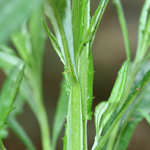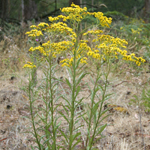African daisy
African daisy is a perennial herb or shrub. It can grow up to 3m tall and has yellow flowers.
Common name:
- African daisy
Scientific name:
- Senecio pterophorus DC.
Other common name:
- Winged Groundsel
Plant status
Catchment management authority boundaries
Regionally prohibited in the Wimmera, North Central, Corangamite, Goulburn Broken, North East and West Gippsland catchments
Regionally controlled in the Glenelg Hopkins, Port Phillip and Western Port catchments
Restricted in the Mallee and East Gippsland catchments
Plant biology

Appearance
Herbaceous plant — Forb (flowering herbaceous plant - not a grass).
Description
Erect perennial herb or shrub.
Stems
African daisy has several stems growing from a central crown, generally 1 to 1.5m high but can reach a height of up to 3m.
When young, stems are soft and sappy. When mature, stems are stout and woody and grey-green to green in colour. They have parallel, raised ridges (or wings) that run the length of the stem and are serrated on the lower sections.
The stems of the young plants are usually covered with white hairs like cobwebs but become smooth and hairless upon maturity.

Leaves
Leaves are dark green on the upper surface, leathery and rough, becoming hairless and often shiny.
The underside of the leaf is covered with dense white or grey woolly hairs.
Narrow, lanceolate (lance-shaped) leaves, 50 to 120mm long, and 3 to 25mm (typically 7 to 15mm) wide. Leaf margins have 2 to 8 forwardly directed teeth. Upper leaves may not have teeth.
Flowers
Numerous yellow, flattened heads between 50 to 300mm across at the ends of the stems.
Each head consists of 40 to 200 or more flowers. Flowers are bell-shaped, 12 to 15mm wide, each surrounded by 18 to 22 bracts with hairy brown tips and up to 20 shorter, smaller bracteoles.
Fruit
No fruit.
Seeds
Seeds are 1.5 to 2mm long, oblong to cylindrical in shape and brown or reddish-brown in colour. They have a pappus of fine hairs to 5mm long that is readily detached.
Seeds tolerate intermittent water logging and ranges in salinity between moderate to quite high.
Growth and lifecycle
Method of reproduction and dispersal
The pappus of the seed is easily shed, so seed are rarely dispersed far from the parent plant by wind. Some dispersal can occur through seed moving in water over the ground. Seeds are also carried in mud which is stuck to animals, clothing and machinery or in contaminated agricultural produce and road-making materials.
Rate of growth and spread
Seedlings establish quickly and compete aggressively with developing pastures and crops.
Seedbank propagule persistence
Mature plants may persist for 7 to 10 years and produce approximately 50,000 seeds annually, with up to 80 per cent of seeds germinating in autumn.
Preferred habitat
African daisy grows well in lowland grassland, grassy woodlands and dry sclerophyll forests.
It prefers humid and sub humid subtropical and warm-temperate savannahs, where it is mainly found on medium and lighter soil types.
It occurs as a weed of disturbed soils along roadsides and in denuded grazing land, newly-sown pastures, forest margins and wastelands. Also after events such as bushfires and clearing.
Distribution
Numerous infestations of African daisy have been found in Victoria:
- southern Wimmera and South West
- Avoca-Maryborough-Clunes area
- areas near Horsham, Dandenong, Bendigo, Mildura
- Port Phillip region.
Growth calendar
The icons on the following table represent the times of year for flowering, seeding, germination, the dormancy period of African daisy and also the optimum time for treatment.
| Jan | Feb | Mar | Apr | May | Jun | Jul | Aug | Sep | Oct | Nov | Dec | |
|---|---|---|---|---|---|---|---|---|---|---|---|---|
| Flowering |  |  | ||||||||||
| Seeding | ||||||||||||
| Germination | ||||||||||||
| Dormancy | ||||||||||||
| Treatment |
Impact
Impact on ecosystems and waterways
African daisy is a strong competitor in natural environments and forms dense thickets that exclude native plant species, resulting in a reduction in habitat.
Agricultural and economic impacts
It contains toxic alkaloids but is rarely eaten by grazing livestock and competes aggressively with developing pastures and crops, often becoming dominant in the early years rendering infested lands unproductive.
Management
Prescribed measures for the control of noxious weeds:
- application of a registered herbicide
- physical removal.
Read about prescribed measures for the control of noxious weeds.
Other management techniques
Changes in land use practices and spread prevention may also support African daisy management after implementing the prescribed measures.